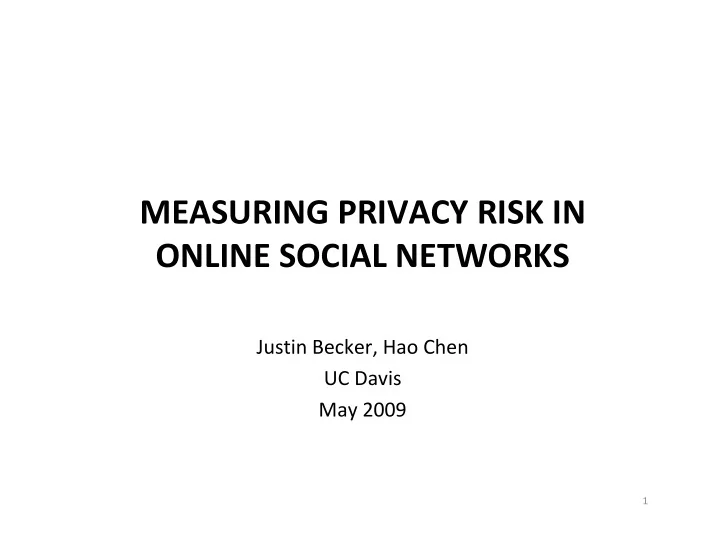

MEASURING PRIVACY RISK IN ONLINE SOCIAL NETWORKS Justin Becker, Hao Chen UC Davis May 2009 1
Motivating example College admission Kaplan surveyed 320 admissions offices in 2008 • 1 in 10 admissions officers viewed applicants’ online profiles • 38% said they had “negative impact” on applicants • If only we could measure privacy risk 2
Scale of Facebook • 200 million active users • 100 million users log on once a day • 1 billion pieces of content shared each week • More than 20 million users update their status daily http://www.facebook.com/press/info.php?statistics 3
Will users take action? Online survey using a simple tool • Calculated privacy risk • Information revealed to third party applications • Reported score to participant • Results • 105 participants • 65% said they would change privacy settings 4
Demographics • 47 men and 24 women • The average age was 23.89 with – standard deviation of 6.1 and a range of 14-44. • 12 different countries Canada, China, Ecuador, Egypt, Iran, Malaysia, New Zealand,Pakistan, Singapore, South – Africa, United Kingdom, United States 5
PrivAware • A tool to – measure privacy risks – suggest user actions to alleviate privacy risks • Developed using Facebook API – Can query user and direct friends profile information – Measures privacy risk attributed to social contacts 6
Threat model • Let user t be the inference target. • Let F be the set of direct friends . • Infer the attributes of t from F. User t t Direct friends f1 f2 f3 f1 f2 f3 7
Threat model 8
Example Can we derive a user affiliation from their friends? 9
Example 10
Example Affiliation Frequency Facebook 32 Harvard 17 San Francisco 8 Silicon Valley 4 Berkeley 2 Google 2 Stanford 2 11
PrivAware implementation • A user must agree to install PrivAware • Due to Facebook’s liberal privacy policy PrivAware can – Access the user’ s profile – Access the profiles of all the user’s direct friends 12
Threats 1) Friend threat Derive private attributes via mutual friends • 2) Non-friend threat Derive private attributes via friends public • attributes Derive private attributes via mutual friends • 3) Malicious applications Derive private attributes via friends public • attributes 13
Inferring attributes Algorithm: select the most frequent attribute value among the user’s friends Friend attributes Education [ UC Davis :7, Stanford:2, UCLA:4] Employer [ Google :10, LLNL:8, Microsoft:2 ] Relationship [ Married :9, Single:5, In a relationship:7] Inferred values Education UC Davis Employer Google Relationship Married 14
Evaluation metrics 1) Inferable attributes • Attribute can be inferred 2) Verifiable inferences • Inferred attributes can be validated against profile 3) Correct inferences • Verifiable inferences equals profile attribute 15
Validation example Inferred values Classification Score Education UC Davis Inferred attributes 3 Employer Google Relationship status Married Verifiable inferences 2 Correct inferences 1 Actual values Education UC Davis Employer LLNL 16
Data disambiguation Decide if different attribute values are semantically equal Variants for University of California, Berkeley • UC Berkeley • Berkeley • Cal 17
Approaches for Disambiguation • Dictionary lookup • Keywords and synonyms • Edit distance • Levenstein algorithm • Named entity recognition 18
Social contacts Total people 93 Total social contacts 12,523 Average social contacts / person 134 19
Inference results Total inferred attributes 1,673 Total verifiable inferences 918 Total attributes correctly inferred 546 Correctly inferred 60% 20
21
Inference prevention Goals • Minimize the number of inferable attributes – Maximize the number of friends – Approaches • Move risky friends into private groups – Delete risky friends – 22
Inference prevention • Optimal solution – Derive privacy scores for each permutation of friends, select permutation with the lowest score – Runtime complexity: O(2 n ) 23
Inference prevention • Heuristic approaches – Remove friends randomly – Remove friends with most attributes – Remove friends with most common friends 24
25
Related work • To join or not to join: The illusion of privacy in social networks… [www2009] • On the need for user-defined fine-grained access control… [CIKM 2008] • Link privacy in social networks [SOSOC 2008] • Privacy Protection for Social Networking Platforms [W2SP 2008] 26
Future work • Improve existing algorithms – NLP techniques – Data mining applications • Include additional threat models – User updates – Friends tagging content – Fan pages • Expand into domains other than social networks – Email – Search 27
Conclusion • Measure privacy risks caused by friends • Improve privacy by identifying risky friends On average, using the common friend heuristic, users need to delete or group 19 less users , to meet their desired privacy level, than randomly deleting friends 28
Recommend
More recommend